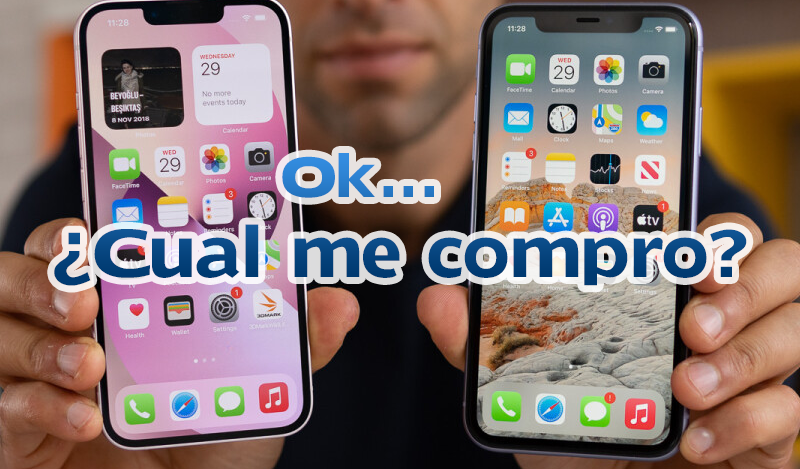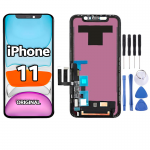What screen should I buy for an iPhone 11?
Publicado por Pablo
Once the original screen of the iPhone 11 is damaged, it is essential to start planning its replacement, and for this, we have alternatives to replace it and choose the best iPhone screen to maintain the quality of the device.
Available screens for the iPhone 11
Before talking about the pros and cons of different screens, it is important to understand how they work, and for that, we will offer a simple summary.
There are two main groups of screens: LCD and LED, which have different types. Among these, a specific group of both interests us, which will ultimately help us choose the best iPhone screen.
LCD Screen
In this sense, LCD screens (Liquid Crystal Display) base their technology on a thin screen that has a group of pixels in the back, called backlight, whose function is to light up like a flashlight. These depend on a connection or energy source, while the iodine substrate liquid is responsible for generating colors through polarizations.
Among the LCD screens, several are available for the iPhone, with TFT and INCELL being the most notable.
TFT Screens
Its name is Thin Film Transistor. It works using semiconductor materials such as silicon, and its technology is applied in liquid crystal displays (LCD). For its application, transistors are placed in each pixel of the screen, and as each transistor decreases, the amount of load for control will also decrease, allowing a quick redraw on the screen.
The aforementioned indicates that thanks to this technology, better fluidity in images can be achieved when in fast motion, thus having an active matrix structure.
As a screen replacement, it is an economical and easy-to-find alternative compared to other screens.
Thanks to its technology, we can enjoy optimal touch response time, making it suitable for video games.
The quality of colors, as well as the saturation, is excellent, but the depth of neutral colors like white or black is not very profound.
Being a type of screen that works connected to a source, in the case of mobiles to their board, they tend to have higher energy consumption, which significantly affects the battery.
They are not thick screens, so there is no noticeable difference when replacing the iPhone 11 complete screen with a TFT type.
INCELL Type
Incell screens are considered the lowest quality, although also the most economical of all. These screens work through multiple electrodes.
One of the biggest complaints from users is that the white color has a blue tone, disturbing the mobile handling experience.
The response time is slightly slower, though nothing to worry about as it does not affect the phone's function. Unless you are a demanding user, in which case it might bother you.
The layers that make up the screen are fewer than traditional LCDs, which is why their thickness is considerably reduced.
The INCELL screen, like iPhone 11 Compatible Screen, also needs to be connected to a source to function, affecting the battery's charging time.
LED Screen
On the other hand, we have LED screens, which work through a large number of pixels whose function is based on diodes, achieving autonomy in each pixel by turning on and off individually as needed without relying on alternate energy sources.
From this family of screens, the one that usually stands out for iPhones and mobiles, in general, is the OLED, thanks to its excellent capability to display HD images with vivid colors and high contrast. From this type of screen, we will consider the OLED type.
OLED Versions
They are screens that work based on an organic light-emitting diode (OLED) technology, which relies on the autonomy of each pixel operating through a diode emitting light. This means they do not need to be connected to an additional source to turn on or off.
The quality and depth of colors are, therefore, the best among the screens mentioned in this article. One of the biggest advantages is their ability to offer deep black color.
Being thin screens, you can enjoy a response time of 0.001 ms.
They specifically have three significant disadvantages:
High price
Pixel damage manifested as black spots on the screen
Limited availability as replacements.
|
Feature |
TFT Screen |
OLED Screen |
INCELL Screen |
|---|---|---|---|
|
Image Quality |
Good |
High |
Medium |
|
Touch Response |
Very Fast |
Very Fast |
Fast |
|
Thickness |
1.1 mm |
1.2 mm |
1.7 mm |
|
Price |
44.50 euros |
57.30 euros |
45.60 euros |
|
Energy Consumption |
Higher |
Lower |
Higher |
|
Useful Life |
Longer lifespan |
Shorter lifespan |
Longer lifespan |
Which would be the best screen for my iPhone 11?
That is why we recommend that if you want to choose the best screen for iPhone 11, it should be an Original OLED. Mainly because of its excellent image quality and being the closest to the original screen.








